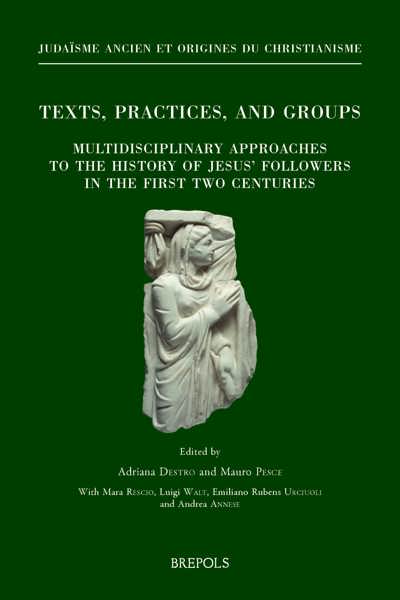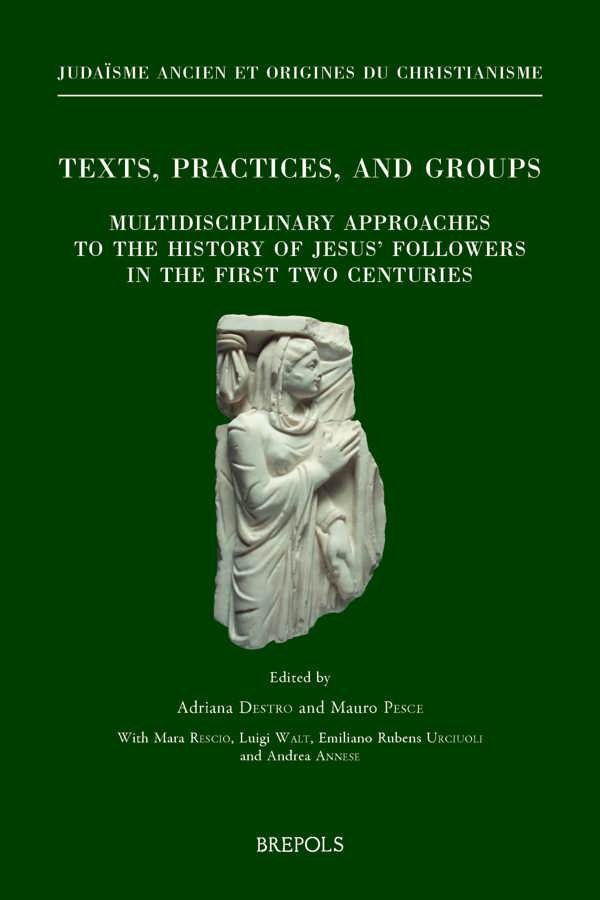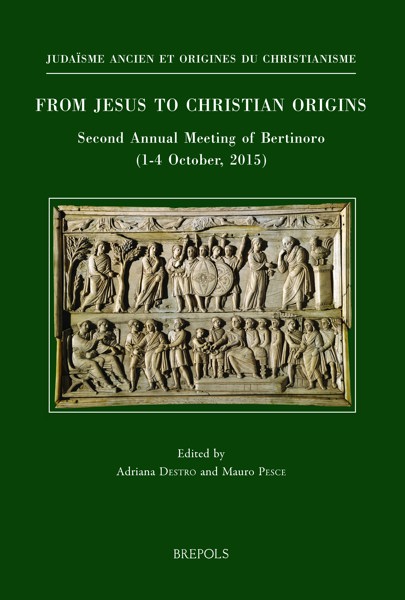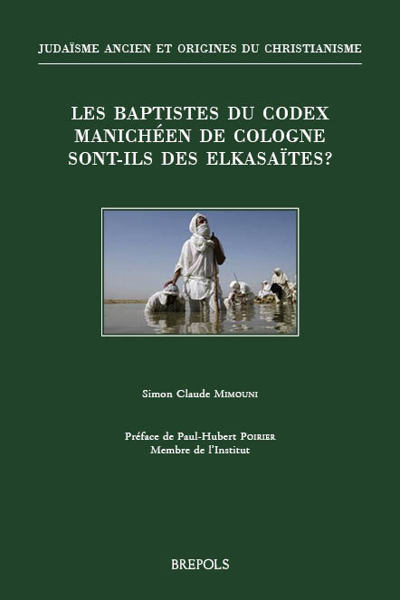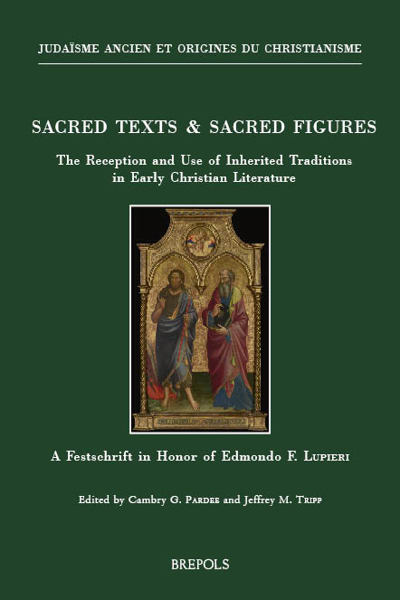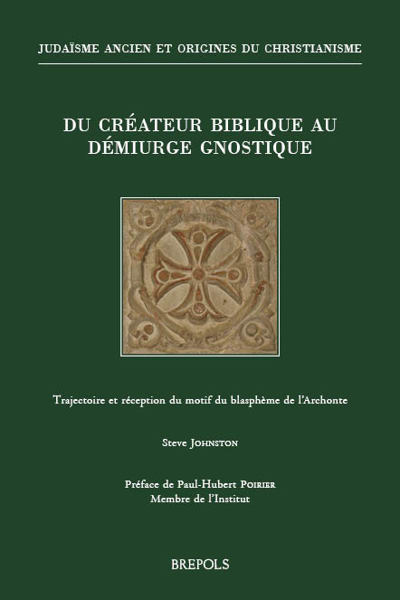
Texts, Practices, and Groups. Multidisciplinary approaches to the history of Jesus’ followers in the first two centuries
First Annual Meeting of Bertinoro (2-5 October 2014)
Adriana Destro, Mauro Pesce (eds)
- Pages: 918 p.
- Size:156 x 234 mm
- Illustrations:51 b/w
- Language(s):English, French, Italian
- Publication Year:2017
- € 145,00 EXCL. VAT RETAIL PRICE
- ISBN: 978-2-503-56901-7
- Paperback
- Available
- € 145,00 EXCL. VAT RETAIL PRICE
- ISBN: 978-2-503-57724-1
- E-book
- Available
Proceedings of the First Meeting of Bertinoro on Early Christianity (2-5 October, 2014).
“Thus, this volume approaches the historical figure of Jesus and the new religion created by his followers from a multidisciplinary perspective, creatively providing a wider knowledge of the social and cultural context of the first two centuries for those readers who are interested in social science, comparative studies, history of biblical interpretation, cultural studies, systematic theology, and modern philosophy.” (David W. Kim, in Cerae, 4, 2017)
Adriana Destro (Professor of Cultural Anthropology, University of Bologna) has published many books on the anthropology of middle East and of religions, including Villaggio Palestinese (Milano, 1977), The Law of Jealousy (Atlanta, 1989), and I volti della Turchia (Roma, 2012).
Mauro Pesce (professor of History of Christianity, University of Bologna) has published on Jesus, early Christianity and the history of biblical interpretation.
The two editors have written together: Antropologia delle origini cristiane (Roma, 2008); Encounters with Jesus. The man in his Place and Time (Fortress Press, 2011); La morte di Gesù (Milano, 2014); Il racconto e la scrittura (Roma, 2014).
Within the contemporary renewal of the exegetical and historical research on Jesus and early Christianity, this book focuses on a wider knowledge of the social and cultural context of the first two centuries, thanks to a systematic research of documentary materials and archaeological data (epigraphs and documentary papyri). Secondly, the book faces the increasingly perceived need to use all the existing literary material for the reconstruction of the historical Jesus and the first groups of his followers. Thirdly, the book stresses the importance of giving space to new epistemological and methodological perspectives in the field of human sciences. The last section of the volume is dedicated to the connection of contemporary research with the interpretations of Jesus and early Christianity developed in the modern age.
Mauro Pesce, Introduction
Part I. Texts and Groups
Dating Early Christian Texts
Markus Vinzent, Marcion of Sinope and the Synoptic Question
Claudio Gianotto, Redating Early Christian Texts. A propos de deux nouvelles hypothèses pour la datation des évangiles canonisés
Historical Jesus
Facundo Daniel Troche, Fishing in the Lake of Galilee and the Socio-Economic Context of Jesus’ Movement
Simone Paganini, Historischer Jesus und eschatologischer Messias. Bemerkungen zu 4Q521 und Lk 7,22 (//Mt 11,15)
Federico Adinolfi, Una redazione piena di memoria. L’indispensabile contributo di Mt 21,31c-32 alla conoscenza storica di Gesù e Giovanni il Battista
Early Texts of Jesus’ Followers and Their Groups
Luigi Walt, Vernacular Reve(i)lations: Paul and the Veil Controversy in Corinth
Mauro Belcastro, Conflits d’intention: Paul, 1 Corinthiens et la pratique de l’ἐκκλησία
Mara Rescio, A Little Lesson in Faith and Prayer: The Sayings Cluster of Mark 11:22‑25
Andrea Annese, The Temple in the Gospel of Thomas. An Interpretive Perspective on Some Words Attributed to Jesus
Giulio Michelini, The Gospel of Matthew and the Gospel of John: Intertextual Connections in three Case Studies (Matt 27:49 // John 19:34; Matt 27:55‑56 // John 19:25‑27; Matt 5:32 // John 7:53-8:11)
Carlo Broccardo, Pantheist, Equilibrist, Opportunist? Luke and the Spirituality of the Gentiles in Acts 17:16‑34
Cora Presezzi, Vasi e concubine. Tracce di un conflitto tra carismi in Samaria secondo Gv 4,7‑30
Francesco Berno, Inauguratio quaedam dividendae doctrinae Valentini: Incon-sistencies about Valentinianism’s Split into duae cathedrae between Adversus Valentinianos and De Carne Christi
Religious Practices
Luca Arcari, Visionary Experiences and Communication in the Revelation of John. Between Selective Memories and Individual Authority
Daniele Tripaldi, Lots, Cups, and Ecstasy: Towards a Reconstruction of the “Thiasoi” of Marcus, Disciple of Valentinus
Maria Dell'Isola, Montanism and Ecstasy: The Case of Theodotus’ Death (Eus.HE V,16,14‑15)
Laura Carnevale, Et de caseo quod mulgebat dedit mihi quasi buccellam. On Charismatic Power, Prophetic Authority and Ritual Practice in Perpetua’s First Vision
Carmine Pisano, The Visionary’s Body as a Dialectical Space of Tradition. The Case of the Pythia
Donatella Tronca, Dancing in Ancient Christianity: Initial Research
History of the Jews and Judaism in the Roman-Hellenistic Period
Dario Garribba, Il 70 d.C. come spartiacque della storia giudaica
Marco Vitelli, Le immagini di Gesù e Giacomo nelle Antiquitates Iudaicae. Un’ipotesi storica sulla loro genesi
Laura C. Paladino, Acta Alexandrinorum. Documenti sull’ebraismo egiziano in età imperiale
Maurizio Marcheselli, Daniel Boyarin sur l’origine du judaïsme et du christianisme
Part II. Anthropology, Methodologies and Modern
Historical Perspectives
Anthropology of Religious Forms and Identities
Adriana Destro, Narrating the Execution of Jesus. Followers, Buriers and Witnesses Confronting the Violent Death of the Leader
Zelda Alice Franceschi, Testimonios as Autobiography. Daily Life and Beliefs among the Wichí in the Argentine Chaco
Maria Chiara Giorda, Contemporary Monastic Studies. First Sketches on Two Case
Studies: Dominus Tecum and Notre-Dame
Francesca Sbardella, Objects Tell Another Story. Gifts Given to the Monastery in Farain Sabina by Cardinal Barberini
Methodological Questions about the Birth of Christianity
Fabrizio Vecoli, La comparaison peut-elle servir à l’histoire? Réflexions méthodologiques à partir de Drudgery Divine de Jonathan Z. Smith
Emiliano Rubens Urciuoli, Religious Vicissitudes of Political Desires. A Bourdieu-Driven
Approach to Early Christian Political Subjectivation
Archaeology and Christian Origins
Carlo Carletti, Origin of Christians’ Epigraphy: an Integration between Different Sources
Paola De Santis, Committenze e funzionalità di un “immaginario figurativo” protocristiano
Antonio Enrico Felle, Documenti epigrafici di committenza ebraica. Omologazione ealterità
Maria Amodio, Tracce archeologiche dei primi credenti in Cristo a Neapolis: le pitture delle catacombe
History of the Modern Research on the Historical Figure of Jesus
Mauro Pesce, The History of Research on the Historical Jesus before Reimarus
Miriam Benfatto, Il Gesù del Ḥizzuk Emunah. Fra ricostruzione critica e costruzione polemica
Franco Motta, A Tale of History, Dogma, and Tradition. Jesus in Caesar Baronius’ Annales ecclesiastici (c. 1560‑1588)
Pina Totaro, Continuity and Discontinuity in Spinoza’s Approach to the Historical Jesus
Alessandro Santagata, Sur la continuité de la « crise moderniste » : de la Lamentabili à la lettre d’Ottaviani sur les erreurs post-conciliaires
Raffaella Cavallaro, Le Jésus d’Antonin Artaud
